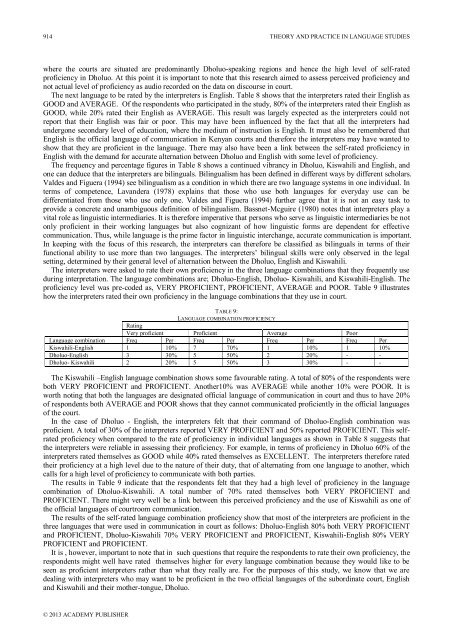Theory and Practice in Language Studies Contents - Academy ...
Theory and Practice in Language Studies Contents - Academy ...
Theory and Practice in Language Studies Contents - Academy ...
Create successful ePaper yourself
Turn your PDF publications into a flip-book with our unique Google optimized e-Paper software.
914 THEORY AND PRACTICE IN LANGUAGE STUDIESwhere the courts are situated are predom<strong>in</strong>antly Dholuo-speak<strong>in</strong>g regions <strong>and</strong> hence the high level of self-ratedproficiency <strong>in</strong> Dholuo. At this po<strong>in</strong>t it is important to note that this research aimed to assess perceived proficiency <strong>and</strong>not actual level of proficiency as audio recorded on the data on discourse <strong>in</strong> court.The next language to be rated by the <strong>in</strong>terpreters is English. Table 8 shows that the <strong>in</strong>terpreters rated their English asGOOD <strong>and</strong> AVERAGE. Of the respondents who participated <strong>in</strong> the study, 80% of the <strong>in</strong>terpreters rated their English asGOOD, while 20% rated their English as AVERAGE. This result was largely expected as the <strong>in</strong>terpreters could notreport that their English was fair or poor. This may have been <strong>in</strong>fluenced by the fact that all the <strong>in</strong>terpreters hadundergone secondary level of education, where the medium of <strong>in</strong>struction is English. It must also be remembered thatEnglish is the official language of communication <strong>in</strong> Kenyan courts <strong>and</strong> therefore the <strong>in</strong>terpreters may have wanted toshow that they are proficient <strong>in</strong> the language. There may also have been a l<strong>in</strong>k between the self-rated proficiency <strong>in</strong>English with the dem<strong>and</strong> for accurate alternation between Dholuo <strong>and</strong> English with some level of proficiency.The frequency <strong>and</strong> percentage figures <strong>in</strong> Table 8 shows a cont<strong>in</strong>ued vibrancy <strong>in</strong> Dholuo, Kiswahili <strong>and</strong> English, <strong>and</strong>one can deduce that the <strong>in</strong>terpreters are bil<strong>in</strong>guals. Bil<strong>in</strong>gualism has been def<strong>in</strong>ed <strong>in</strong> different ways by different scholars.Valdes <strong>and</strong> Figuera (1994) see bil<strong>in</strong>gualism as a condition <strong>in</strong> which there are two language systems <strong>in</strong> one <strong>in</strong>dividual. Interms of competence, Lav<strong>and</strong>era (1978) expla<strong>in</strong>s that those who use both languages for everyday use can bedifferentiated from those who use only one. Valdes <strong>and</strong> Figuera (1994) further agree that it is not an easy task toprovide a concrete <strong>and</strong> unambiguous def<strong>in</strong>ition of bil<strong>in</strong>gualism. Bassnet-Mcguire (1980) notes that <strong>in</strong>terpreters play avital role as l<strong>in</strong>guistic <strong>in</strong>termediaries. It is therefore imperative that persons who serve as l<strong>in</strong>guistic <strong>in</strong>termediaries be notonly proficient <strong>in</strong> their work<strong>in</strong>g languages but also cognizant of how l<strong>in</strong>guistic forms are dependent for effectivecommunication. Thus, while language is the prime factor <strong>in</strong> l<strong>in</strong>guistic <strong>in</strong>terchange, accurate communication is important.In keep<strong>in</strong>g with the focus of this research, the <strong>in</strong>terpreters can therefore be classified as bil<strong>in</strong>guals <strong>in</strong> terms of theirfunctional ability to use more than two languages. The <strong>in</strong>terpreters’ bil<strong>in</strong>gual skills were only observed <strong>in</strong> the legalsett<strong>in</strong>g, determ<strong>in</strong>ed by their general level of alternation between the Dholuo, English <strong>and</strong> Kiswahili.The <strong>in</strong>terpreters were asked to rate their own proficiency <strong>in</strong> the three language comb<strong>in</strong>ations that they frequently usedur<strong>in</strong>g <strong>in</strong>terpretation. The language comb<strong>in</strong>ations are; Dholuo-English, Dholuo- Kiswahili, <strong>and</strong> Kiswahili-English. Theproficiency level was pre-coded as, VERY PROFICIENT, PROFICIENT, AVERAGE <strong>and</strong> POOR. Table 9 illustrateshow the <strong>in</strong>terpreters rated their own proficiency <strong>in</strong> the language comb<strong>in</strong>ations that they use <strong>in</strong> court.TABLE 9:LANGUAGE COMBINATION PROFICIENCYRat<strong>in</strong>gVery proficient Proficient Average Poor<strong>Language</strong> comb<strong>in</strong>ation Freq Per Freq Per Freq Per Freq PerKiswahili-English 1 10% 7 70% 1 10% 1 10%Dholuo-English 3 30% 5 50% 2 20% - -Dholuo- Kiswahili 2 20% 5 50% 3 30% - -The Kiswahili –English language comb<strong>in</strong>ation shows some favourable rat<strong>in</strong>g. A total of 80% of the respondents wereboth VERY PROFICIENT <strong>and</strong> PROFICIENT. Another10% was AVERAGE while another 10% were POOR. It isworth not<strong>in</strong>g that both the languages are designated official language of communication <strong>in</strong> court <strong>and</strong> thus to have 20%of respondents both AVERAGE <strong>and</strong> POOR shows that they cannot communicated proficiently <strong>in</strong> the official languagesof the court.In the case of Dholuo - English, the <strong>in</strong>terpreters felt that their comm<strong>and</strong> of Dholuo-English comb<strong>in</strong>ation wasproficient. A total of 30% of the <strong>in</strong>terpreters reported VERY PROFICIENT <strong>and</strong> 50% reported PROFICIENT. This selfratedproficiency when compared to the rate of proficiency <strong>in</strong> <strong>in</strong>dividual languages as shown <strong>in</strong> Table 8 suggests thatthe <strong>in</strong>terpreters were reliable <strong>in</strong> assess<strong>in</strong>g their proficiency. For example, <strong>in</strong> terms of proficiency <strong>in</strong> Dholuo 60% of the<strong>in</strong>terpreters rated themselves as GOOD while 40% rated themselves as EXCELLENT. The <strong>in</strong>terpreters therefore ratedtheir proficiency at a high level due to the nature of their duty, that of alternat<strong>in</strong>g from one language to another, whichcalls for a high level of proficiency to communicate with both parties.The results <strong>in</strong> Table 9 <strong>in</strong>dicate that the respondents felt that they had a high level of proficiency <strong>in</strong> the languagecomb<strong>in</strong>ation of Dholuo-Kiswahili. A total number of 70% rated themselves both VERY PROFICIENT <strong>and</strong>PROFICIENT. There might very well be a l<strong>in</strong>k between this perceived proficiency <strong>and</strong> the use of Kiswahili as one ofthe official languages of courtroom communication.The results of the self-rated language comb<strong>in</strong>ation proficiency show that most of the <strong>in</strong>terpreters are proficient <strong>in</strong> thethree languages that were used <strong>in</strong> communication <strong>in</strong> court as follows: Dholuo-English 80% both VERY PROFICIENT<strong>and</strong> PROFICIENT, Dholuo-Kiswahili 70% VERY PROFICIENT <strong>and</strong> PROFICIENT, Kiswahili-English 80% VERYPROFICIENT <strong>and</strong> PROFICIENT.It is , however, important to note that <strong>in</strong> such questions that require the respondents to rate their own proficiency, therespondents might well have rated themselves higher for every language comb<strong>in</strong>ation because they would like to beseen as proficient <strong>in</strong>terpreters rather than what they really are. For the purposes of this study, we know that we aredeal<strong>in</strong>g with <strong>in</strong>terpreters who may want to be proficient <strong>in</strong> the two official languages of the subord<strong>in</strong>ate court, English<strong>and</strong> Kiswahili <strong>and</strong> their mother-tongue, Dholuo.© 2013 ACADEMY PUBLISHER
















